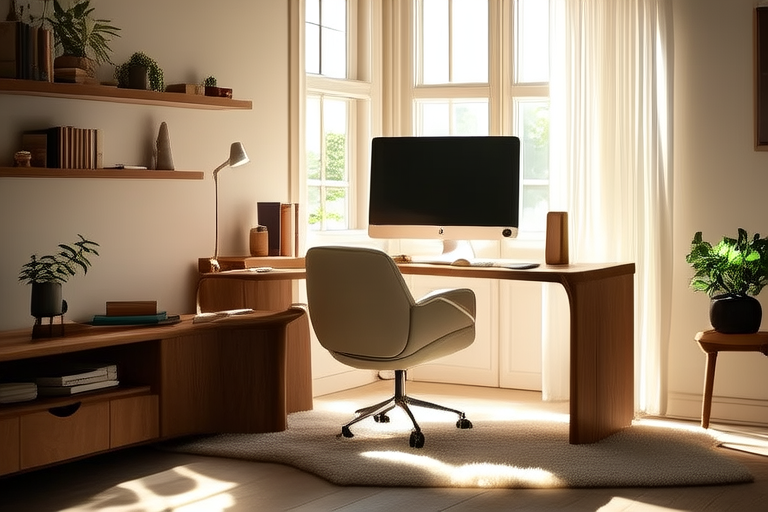Introduction
In today’s fast-paced world, many of us spend a significant portion of our day in an office environment. Whether you’re working from home or in a corporate setting, the design of your workspace can have a profound impact on your health, productivity, and overall well-being. A cozy and comfortable office space not only enhances your physical comfort but also boosts your mental clarity and creativity. In this article, we’ll explore how to design an office that maximizes health benefits, ensuring you feel both productive and at ease.
The Importance of Ergonomics
One of the most critical aspects of designing a healthy office space is ergonomics. Ergonomics refers to the study of how people interact with their environments, particularly focusing on optimizing comfort, efficiency, and safety. Poor ergonomics can lead to various health issues, including back pain, neck strain, and repetitive stress injuries. Here’s how you can ensure your workspace is ergonomically sound:
Adjustable Furniture
Invest in adjustable chairs and desks. An ergonomic chair should support your lower back, allow for proper posture, and be height-adjustable. Similarly, a sit-stand desk can help reduce the risk of prolonged sitting, which has been linked to numerous health problems. By alternating between sitting and standing throughout the day, you can improve circulation and reduce muscle stiffness.
Proper Desk Setup
Position your monitor at eye level and about an arm’s length away. This helps prevent neck strain and eye fatigue. Ensure that your keyboard and mouse are within easy reach, and your wrists remain in a neutral position while typing. Additionally, consider using footrests if your feet don’t rest flat on the floor when seated.
Lighting and Air Quality
Lighting and air quality are often overlooked but play a crucial role in maintaining a healthy office environment.
Natural Light and Artificial Lighting
Natural light is essential for maintaining circadian rhythms and boosting mood. If possible, place your desk near a window to take advantage of natural sunlight. For artificial lighting, opt for soft, warm bulbs that mimic natural light. Avoid harsh fluorescent lights, which can cause eye strain and headaches. Layer your lighting by incorporating task lighting (e.g., desk lamps) and ambient lighting (e.g., ceiling fixtures).
Ventilation and Humidity Control
Poor ventilation can lead to stuffy air and increased concentration on pollutants, affecting your respiratory system. Ensure that your office space has adequate airflow by opening windows when possible or using air purifiers. Additionally, maintain optimal humidity levels—between 30% and 50%—to prevent dryness or excess moisture that could encourage mold growth.
Incorporating Greenery and Personal Touches
Adding plants and personal items to your workspace can enhance your mood and create a more inviting atmosphere.
The Benefits of Indoor Plants
Indoor plants not only beautify your space but also improve air quality by filtering out toxins and increasing oxygen levels. Some popular low-maintenance options include spider plants, peace lilies, and snake plants. Place these strategically around your desk to enjoy their aesthetic and health benefits.
Personalizing Your Space
Surround yourself with items that bring you joy and inspiration. These might include family photos, artwork, or motivational quotes. Personalizing your space can boost your morale and make you feel more connected to your work environment.
Practical Tips for Creating a Cozy Office
Here are some actionable steps to help you design a cozy and comfortable office space:
- Assess Your Needs: Before making any changes, evaluate what you need from your workspace. Consider factors like the type of work you do, the amount of storage required, and how much time you spend there.
- Declutter Regularly: Keep your desk tidy to avoid distractions and reduce stress. Use organizers, drawers, and shelves to store supplies neatly.
- Use Soft Furnishings: Add elements like area rugs, cushions, and throws to create a warm and inviting atmosphere. These items can also provide additional comfort during long hours of sitting.
- Soundproofing: If noise is an issue, consider adding soundproof panels or thick curtains to minimize external disturbances.
Conclusion
Designing a cozy and comfortable office space goes beyond aesthetics; it’s about creating an environment that promotes health, happiness, and productivity. By prioritizing ergonomics, optimizing lighting and air quality, and incorporating personal touches, you can transform your workspace into a haven that supports your well-being. Start by making small adjustments and gradually build up to a fully optimized setup. Remember, a healthier workspace leads to a healthier you!
Actionable Steps:
- Invest in adjustable furniture and proper desk setups.
- Improve lighting and air quality.
- Incorporate greenery and personalize your space.
- Regularly declutter and use soft furnishings.
By following these guidelines, you’ll be well on your way to enjoying the full health benefits of a thoughtfully designed office space.
